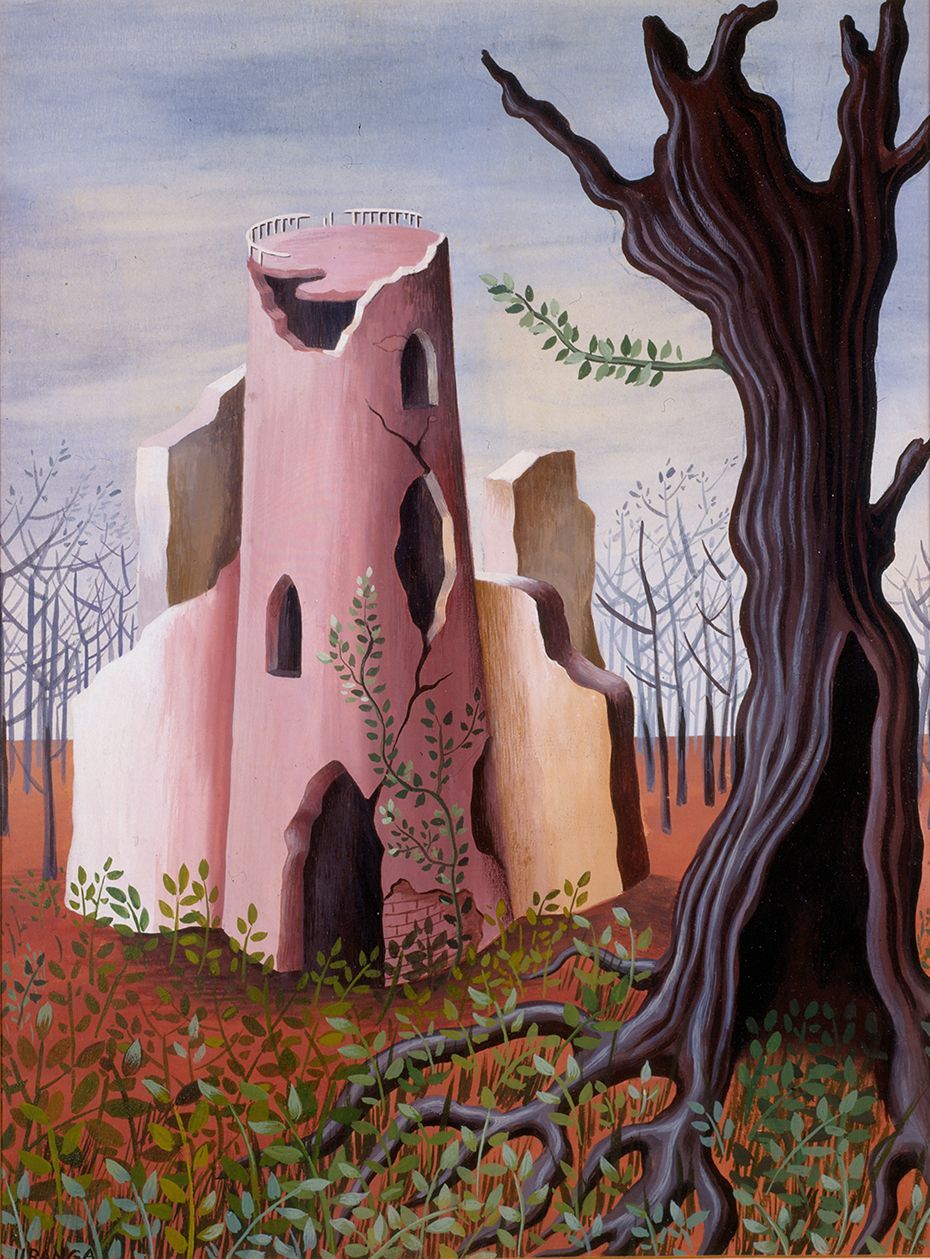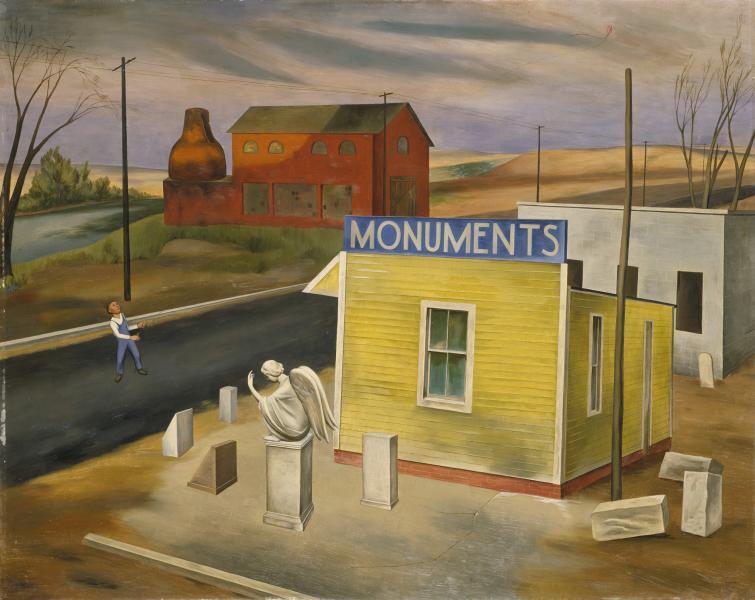“All was moorland loneliness and midnight hush.”
(Jane Eyre)
 John Corbet, The Tower, 2020, watercolour
John Corbet, The Tower, 2020, watercolour
John Corbet is one of my favourite contemporary artists; I enjoyed seeing his style develop throughout the years and I am always curious to see what wonderful and dreamy watercolours and pastels his brush and his imagination will give birth to. I already wrote about his Renoir inspired watercolour here. One of his most recent works called “The Tower” was a love at first sight for me. It’s hard to explain what particular element of the watercolour appeals to me so much because I love all of it; first of all, it’s easy to seduce me with watercolours, then I just love the colours; hushed and melancholy shades of purple, greys and blues, like a cloudy sky just moments before a rainstorm. The scene excites my imagination and the mystery compels me to further gaze at the painting. A pale young girl is seen running over the moors, her purple dress, like a fragrant and large violet petal, swamps the lower part of the paper, flowing like a deep purple river, widening down from her slender waist.
One can just feel the Gothic mood of the watercolour, the mystery and suspense, shining through in dark colours and objects that seemed to serves as symbols open to interpretation, for example the looming yellowish tower on the hill; it can symbolise the captivity, a bird cage for the young maiden, or a protection from the harsh realities symbolised by the darkness and gloom of the strange moors and meadows she found herself in, it can be a prison and a safe haven, depends on what you wish you see. Its erect shape and unbreakable strength could also bring to mind other things, in a Freudian way. Also, the motif of a tower instantly brought to mind the painting “Vejez” by a female Spanish-Mexican Surreliast painter Remedios Varo. In the painting, a pink tower is shown to be full of cracks and starting to be overgrown by ivy, and it certainly has a lot of character despite being an object.
Without a doubt, there is a secret connection between the innocent Gothic maiden and the stern face vaguely yet convincingly appearing in the grey cloud. I will imagine it is her strict guardian watching over her, in spirit, even when he is not near her in flesh. “When I’m not there, in spirit I’ll be there”, to quote Depeche Mode’s song “Disease”. Her eyes are turned upwards; she can sense his gaze upon her and she knows there is no way to escape, no matter how fast or far she ran over the meadows and moors, she knows that her guardian transcends both time and space. The girl’s hair dancing in the melody of the wind and the raspberry pink ribbons on her sleeves form a repeating pattern and add to the scene’s drama and a whirlwind of intensity.

Remedios Varo, Vejez, 1948
The stern face in the cloud and the round rosy-cheeked face of the maiden in a violet-gown brought to mind the mystical connection between Jane Eyre and Mr Rochester when they both, at the same moment, around midnight, heard each other’s voices and cries, coming from kilometers afar, more through the power of mind than physically through space:
“All the house was still; for I believe all, except St. John and myself, were now retired to rest. The one candle was dying out: the room was full of moonlight. My heart beat fast and thick: I heard its throb. Suddenly it stood still to an inexpressible feeling that thrilled it through, and passed at once to my head and extremities. The feeling was not like an electric shock, but it was quite as sharp, as strange, as startling: it acted on my senses as if their utmost activity hitherto had been but torpor, from which they were now summoned and forced to wake. They rose expectant: eye and ear waited while the flesh quivered on my bones.
“What have you heard? What do you see?” asked St. John. I saw nothing, but I heard a voice somewhere cry —
“Jane! Jane! Jane!” — nothing more.
“O God! what is it?” I gasped.
I might have said, “Where is it?” for it did not seem in the room — nor in the house — nor in the garden; it did not come out of the air — nor from under the earth — nor from overhead. I had heard it — where, or whence, for ever impossible to know! And it was the voice of a human being — a known, loved, well-remembered voice — that of Edward Fairfax Rochester; and it spoke in pain and woe, wildly, eerily, urgently.
“I am coming!” I cried. “Wait for me! Oh, I will come!” I flew to the door and looked into the passage: it was dark. I ran out into the garden: it was void.
“Where are you?” I exclaimed.
The hills beyond Marsh Glen sent the answer faintly back — “Where are you?” I listened. The wind sighed low in the firs: all was moorland loneliness and midnight hush.”


Jane Eyre (2011): In spirit, I believe we must have met.
And here is what Mr Rochester tells Jane later on, when they meet again:
“As I exclaimed ‘Jane! Jane! Jane!’ a voice- I cannot tell whence the voice came, but I know whose voice it was- replied, ‘I am coming: wait for me;’ and a moment after, went whispering on the wind the words- ‘Where are you?’ “I’ll tell you, if I can, the idea, the picture these words opened to my mind: yet it is difficult to express what I want to express. Ferndean is buried, as you see, in a heavy wood, where sound falls dull, and dies unreverberating. ‘Where are you?’ seemed spoken amongst mountains; for I heard a hill-sent echo repeat the words. Cooler and fresher at the moment the gale seemed to visit my brow: I could have deemed that in some wild, lone scene, I and Jane were meeting. In spirit, I believe we must have met. You no doubt were, at that hour, in unconscious sleep, Jane: perhaps your soul wandered from its cell to comfort mine; for those were your accents- as certain as I live- they were yours!” Reader, it was on Monday night- near midnight- that I too had received the mysterious summons: those were the very words by which I replied to it.“
In the same way, we know the face in the cloud cannot be real but we can imagine what powerful bonds connects their spirits that the girl can feel his gaze upon her even when she is out on the meadow.
You can visit the artist’s page here.
Tags: art, artist, Charlotte Brontë, clouds, contemporary art, dark, Dreamy, fairy tale, Jane Eyre, John Corbet, meadow, moors, Painting, Remedios Varo, The Tower, tower, transcendetal, Vejez, watercolour
 Eugene Grasset, Young Girl in the Garden, date unknown, watercolour
Eugene Grasset, Young Girl in the Garden, date unknown, watercolour





























